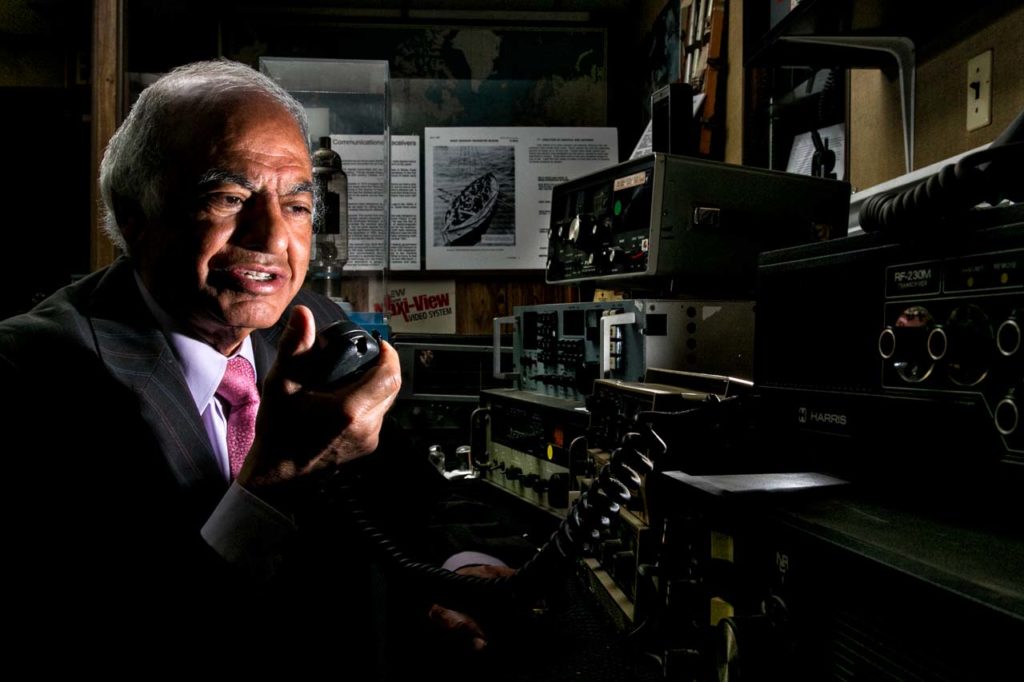for this island icon, a labor of love comes to fruition in the form of the Museum of Maritime Navigation and Communication of New York
by JENNIFER VIKSE • Photos By Amessé Photography
You might have heard of Sam Farag. It could be because of his volunteer work, or from the company he founded, Worldwide Electronic Corporation. Or maybe it’s because of his most recent venture, the Museum of Maritime Navigation and Communication. But even if you’re not quite clear about where you’ve heard the name, you can be sure it has something to do with our borough. Because, many would say, Samir “Sam” Farag is Staten Island.

It might seem unlikely that Farag, born in Egypt and raised in Lebanon, would even discover this place, let alone fall in love with it and devote his life to making it better.
But that’s exactly what happened.
After earning his engineering degree in Lebanon, he emigrated to the United States in 1969 in search of work. He arrived at John F. Kennedy Airport with little in the way of money or prospects, and stepped off into the unknown.
“I was really scared, but I said, ‘I’ll give myself a year. If I can’t make it, I’ll go back to Lebanon,’ ” he recalled. That notion seems almost funny now, he said.
He got his first job as an engineer in White Plains, New York, and stayed there for six months. When the commute from Manhattan became too much, he decided to consider his options. He had heard about Staten Island, so ventured over to look for work in a local shipyard.
All the while, he admitted, he was nervous about speaking the language. “I knew English, but I was afraid to make a mistake. I went to the library to learn to speak,” he said.
Farag moved to Staten Island, and managed to get a job in the maritime navigation and communications field. At the time, it was an unusual place for an electronics engineer.
“I knew how to fix small electronics. That gave me a niche. I liked it,” Farag remembered. “It was a challenge for me. I got to meet the captain of a ship, which had a huge impact. He had something like 37 people working for him…said the ship was like a small country in the water.”
That, in some ways, began the rest of his life, as Farag became increasingly enamored of all things maritime. “The marine industry fascinated me—the big ships, the challenge,” he said. “It’s a niche; it’s unique.”

Farag remained with the company for seven years. Then, in 1976, he began Worldwide Electronic Corporation of Staten Island, an engineering firm specializing in electronic equipment for maritime and other commercial industries. The company grew quickly, and Farag found himself amassing a substantial collection of navigational equipment.
“The technology started moving fast,” he said. Every three or four years, the U.S. Coast Guard would reissue navigational rules and regulations, creating an urgent need for new equipment. That, of course, made some of the old equipment obsolete. “I would take the old pieces of equipment,” he said. “I thought that maybe I would use them. I kept them intact.”
The years passed, and Farag eventually found himself staring at three floors of equipment at his company building in Rosebank.
The owner, who at this point was semi-retired, decided to shift focus slightly and take on another challenge: He created his own museum, utilizing all the navigational and communications gear he’d been collecting for nearly 35 years.
In 2011, his dream became a reality: the Museum of Maritime Navigation and Communication officially became a 501(c)(3) organization.
“I created it to show it to the public, to put different exhibits all over the Island,” the museum’s founder noted. Through extensive community relationships, Farag has been able to put together a series of traveling exhibits that visit different Staten Island venues. He created, for instance, a program on Morse code for the Staten Island Children’s Museum and a folk life exhibit at the Staten Island Ferry Terminal.
Once the museum was established and the collection had a home, there was no looking back. It now welcomes visitors at its Bay Street location six days a week, with a mission to preserve marine electronic equipment and local maritime history through programs for children and adults that stimulate their interest and encourage further exploration.
The storefront museum includes some 500 pieces. The collection chronicles the history of navigation technology, from the days of the sextant to modern GPS. On display are transmitter radios, receivers, radar equipment, walkie talkies, satellite navigators, LORAN systems, depth finders, and more. The oldest electronic piece, a receiver, dates back to 1939. “I have everything from the beginning of equipment,” Farag said. “You can see them. All of the electronics are working. I can turn any unit on.”

Feedback from visitors has been overwhelmingly positive. They can select a piece of equipment on a tablet and hear the description and the history of that item. Between the school visits and the tourists, the museum is usually busy. Farag thinks that while students are aware of the technology they carry around with them in the form of phones and game consoles, they may not realize that the technology they often take for granted has a long and colorful history.
“Too many people forget where today’s technology came from,” he said, adding that the excitement from students he welcomed from area colleges last semester—including the College of
Staten Island, Brooklyn College, and others—was particularly satisfying.
Farag credits Staten Island’s elected officials for a great deal of assistance.
“I’ve gotten a lot of support,” he said. “They appreciate what we are trying to do.” And all the buzz the museum has created means Farag routinely gets offers for donations of additional equipment.
Try as he might, the founder doesn’t seem to be slowing down. Besides his full-time fervor for the museum, he serves as a SCORE mentor and past chairman (since 1980, SCORE has helped more than 500 Staten Islanders a year start or expand their small businesses). He is also president of the Foundation at the College of Staten Island and chairman of the Staten Island Not-for-Profit Association. He is on the board of both the Staten Island Children’s Museum and the Staten Island YMCA, and is a member of the Rotary Club, the Downtown Staten Island Council, the Steamship Club, the Job Serve Employer Committee, the Jewish Community Center of Staten Island Advisory Council, and other organizations. He has received numerous distinctions, including the Staten Island Rotary Club Giants Award, the Eden II Programs Community Service Award, and the Louis R. Miller Business Leadership Award.
“I love Staten Island,” he said. “I am on so many boards. Everybody asks me, so I can’t say the word no.”
Farag and his wife, Lisette, live in mid-Island.
“I don’t think I will ever sit down and really retire,” he said. “I want to leave a legacy.”
The Museum of Maritime Navigation and Communication
1208 Bay Street / 718.448.1717 / mmncny.org
